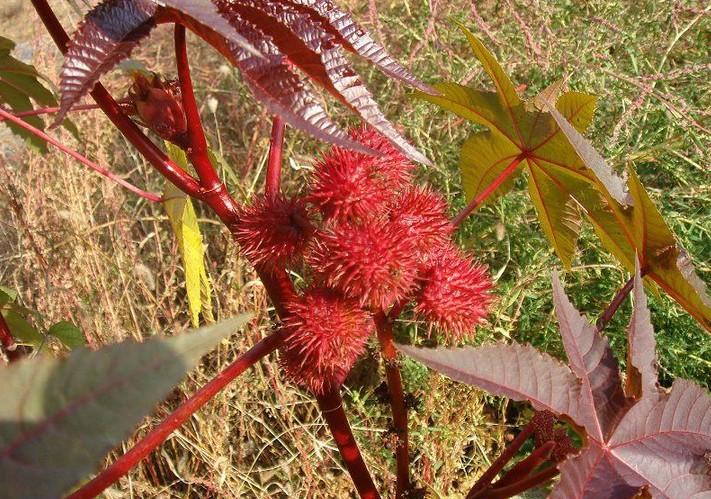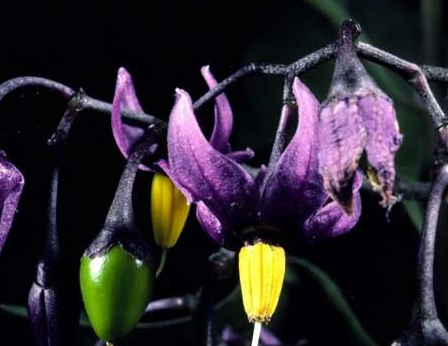5.蓖麻
The castor bean plant, or Ricinus communis, is widely cultivated for its castor oil and is also used as an ornamental plant. Neither of these uses would clue you into the fact that this plant has deadly contents: ricin.
蓖麻子,或蓖麻,一种广泛栽培的植物,以获取其蓖麻油,或作为观赏型植物。这两种用法都掩盖了一个事实,就是这种植物带有毒素:蓖麻毒素。

Castor oil is a mild-tasting vegetable oil that is used in many food additives, flavorings and in candy production. It's also available to the consumer as a laxative and to induce labor (though no scientific evidence shows it's successful in inducing labor). Castor oil comes from the plant's seeds, which are 40 to 60 percent oil. The castor bean plant probably originated in Africa, but is now found throughout the world. This large, shrubby plant is popularly used in gardens because of its hardy nature. It grows well in barren areas and doesn't require special care. It's fast-growing and can reach 36 feet (11 meters) in a season. The flowers of the plant are yellowish green, and the centers of the flowers are red. The leaves are large with toothed edges. Ricin is present in low levels throughout the plant, but it's largely concentrated in the seed coating. Seed poisonings are rare and usually involve children and pets, but they can be deadly. As few as three seeds, which are green with brown markings, could kill a child who swallows them. Symptoms of castor bean poisoning include nausea, abdominal cramps, vomiting, internal bleeding, and kidney and circulation failure. Many people suffer from an allergic reaction to the dust from the seeds and may experience coughing, muscle aches and difficulty breathing. Exposure to the dust is most common in areas where the beans are processed for commercial use. In ancient times, the castor bean was used in ointments, and allegedly, Cleopatra applied the oil to the whites of her eyes to brighten them.
蓖麻油是一种温和的蔬菜油,用在食物添加剂、调味料还有糖果的生产中。它还能用来当泻药和助产(虽然没有科学证据证明可以成功引产)。蓖麻油来自蓖麻的种子,种子含油量为40%~60%。蓖麻一开始是在非洲发现的,现在世界各地都可以看到。这种大型灌木状植物因其强适应性被广泛放在花园中。它不需要特别的照顾,即使在贫瘠的地方也可以生长得很好,并且生长速度很快——一个季度就可以长到36英尺(11米)。该植物的花为浅绿色,花的中心为红色。叶子很大,带有齿状边缘。蓖麻毒素含量比较低,主要集中在种子包衣。蓖麻子中毒虽很罕见,但是一旦发生便是致命的,通常发生在孩子和宠物中。一个孩子只要吞下三颗绿棕条纹的种子就会死亡。蓖麻子中毒的症状包括恶心、腹部痉挛、呕吐、内部出血和肾循环衰竭。许多人对种子上的灰尘都会有过敏反应,可能会咳嗽、 肌肉疼痛、呼吸困难。在人们将其用于商业用途的地区,蓖麻籽一般都暴露在空气中。在古代,蓖麻子用于膏药。据称克娄巴特拉人用蓖麻油涂在眼白部分,让眼睛看起来更亮。
4.颠茄

Deadly nightshade is a perennial plant that grows between 2 and 4 feet (0.6 to 1.2 meters) tall. You'll recognize it by its dull, dark green leaves and bell-shaped purple, scented flowers, which bloom from mid-summer through early fall. Deadly nightshade berries are green when they form and turn to a shiny black as they ripen. They're sweet and juicy, which makes them tempting to children. The plant requires rich, moist soil to thrive, and it grows wild in some areas of the world, but in the United States is limited to cultivation. Not all animals are affected by deadly nightshade. While it's deadly to humans and some animals, horses, rabbits and sheep can eat the leaves without harm, and birds feed on the berries. The poisons contained in deadly nightshade affect the nervous system. Taken in sufficient doses, the deadly poison paralyzes nerve endings in the involuntary muscles of the body, such as the blood vessels, heart and gastrointestinal muscles. Symptoms of deadly nightshade poisoning include dilated pupils, sensitivity to light, blurred vision, headaches, confusion and convulsions. As few as two ingested berries can kill a child, and 10 to 20 berries would kill an adult. Even handling the plant can cause irritation.
颠茄是一种多年生草本植物,可高达2-4英尺(0.6-1.2米)。其叶子呈深绿色;花冠为钟形,淡紫色,有香气;花期一般在仲夏到初秋;浆果未成熟时呈绿色,成熟后变为亮黑色,且甘甜多汁,对孩子们来说,这极具吸引力。颠茄适宜生长在肥沃、湿润的土壤中,野生颠茄分布在世界多地,但美国却没有野生颠茄的存在,全靠人工栽培。尽管颠茄对于人类和有些动物来说是致命的,但总有一些动物不受颠茄毒素影响,例如,马、兔和羊吃了它的叶子却都可以平安无事,鸟类甚至以它的浆果为食。颠茄中所含的有毒物质主要作用于神经系统,如果不慎摄入了足够的剂量,这些致命的有毒物质就会麻痹诸如血管、心脏以及胃肠道肌等人体不随意肌中的神经末梢。其中毒的症状包括瞳孔散大、畏光、视力模糊、头痛、神志不清以及痉挛等。儿童误食两个浆果就会丧命,而10-20个浆果的摄入量也足以造成一个成人死亡。即便是在加工过程中触碰到颠茄植株,也能引起过敏反应。
3.相思子

The rosary pea, or Abrus precatorius, has very pretty seeds. Two-thirds of the seed is red, and the top third is black. These decorative seeds are often used to make jewelry, and that jewelry is imported to other countries. In fact, these seeds are especially popular for rosary prayer beads.
相思子又称鸡母珠,有着非常漂亮的种子。其种子底端的三分之二呈红色,顶端的三分之一呈黑色。这些具有装饰性的种子通常用于制作首饰,首饰也被多国争相进口。实际上,用这些种子做成的念珠则更受欢迎。
But rosary pea seeds contain the poison abrin. The seeds are only dangerous when the coating is broken -- swallowed whole, the rosary pea doesn't present any danger. But if the seed is scratched or damaged, it's deadly. The rosary pea poses greater danger to the jewelry maker than to the wearer. There are many reported cases of death when jewelry makers prick a finger while handling the rosary pea. Rosary pea plant is an aggressive grower and can take over an area if not kept in check. One rosary pea vine can grow and climb more than 20 feet (6 meters) in a single season. The plant, which is native to Indonesia, has spread across the world, in tropic and sub-tropic climates. It's even located in several states in the United States, including Alabama, Arkansas, Florida, Georgia and Hawaii. The plant has long leaves with off-shooting leaflets and red flowers. Abrin, the poison found in the rosary pea seed, is more deadly than ricin. Less than 3 micrograms of abrin in the body is enough to kill, which is less than the amount of poison in one pea. In the human body, abrin bonds to cell membranes and prevents protein synthesis, one of the most important duties of the cell. Symptoms of rosary pea inhalation poisoning are: difficult breathing, fever, nausea and fluid in the lungs. If ingested -- and the seed coating is broken -- rosary pea seeds cause severe nausea and vomiting, which eventually leads to dehydration, and ends with the kidneys, liver and spleen shutting down. Death usually follows within three to four days.
然而,相思子的种子包含相思子毒素。但只有包裹种子的薄膜破损时,它们才会危及人的生命。也就是说,如果不慎吞下了完整的种子,吞食者并不会有任何危险;但如果吞下的种子被划伤或破损了,吞食者就会有生命危险。因而相思子首饰制作者们面临的风险反而比佩戴者更大。许多工匠就是在加工相思子饰品时不小心扎破了手指,不幸中毒身亡。相思子植株的侵略性非常强,如果不加以控制,它们往往会抢占其他生物的生存空间。一株相思子藤蔓一个季度就可以生长超过20英尺(6米)。这一原产于印度尼西亚的物种,现已遍布全球的热带和亚热带地区。甚至在美国的亚拉巴马州、阿肯色州、佛洛里达州、佐治亚州和夏威夷等地都有它的身影。相思子叶片狭长,小叶对生,花朵呈红色。在相思子种子中发现的有毒物质——相思子毒素,其毒性远超过蓖麻毒素。不到3微克的相思子毒素便足以致命,而每颗相思子所含的毒素往往超过3微克。相思子毒素进入人体后,会附着于细胞膜上并阻止蛋白质合成,而合成蛋白质是细胞最重要的功能。若不慎吸入相思子粉尘中毒,其临床症状为:呼吸困难、发热、恶心以及肺水肿。若相思子种子外层的保护膜破损,谁又不幸摄入了相思子毒素,中毒者就会出现严重的恶心呕吐,并由此引发脱水,最终出现肾、肝、脾衰竭。中毒者一般在中毒后三至四天内死亡。
2.水毒芹

The water hemlock, or cicuta maculata, is a very attractive wildflower with an upright growth pattern, purple-striped leaves and small white blooms. But the water hemlock's white roots are sometimes mistaken for a parsnip plant -- a potentially fatal error. The poison contained in the water hemlock, cicutoxin, is present in the entire plant, but is most concentrated in the roots. Anyone who confuses the plant with parsnips and decides to take a bite faces a violent death.
水毒芹,又名斑毒芹,是一种非常漂亮的野花。它属直立草本,长着紫色斑纹叶,白色迷你花瓣。但水毒芹的白色根有时候会被误认为欧防风的根,这种误认可能会造成致命的后果。整株水毒芹都包含有毒物质——毒芹素,但根部的毒芹素含量最高。若把水毒芹错认为欧防风,尝一口也是存在致命风险的。
The water hemlock, which is native to North America, is considered by many to be the most deadly plant on the continent. The wildflower, which grows to 6 feet (1.8 meters), thrives along stream banks, in marshy areas, and in low-lying, damp meadows. For those unlucky enough to taste the water hemlock, the onset of illness is rapid. The cicutoxin contained in the plant causes violent and painful convulsions, nausea, vomiting, cramps and muscle tremors. Those who survive the poisoning experience long-term health conditions, such as amnesia. No amount of water hemlock root is considered safe to ingest.
水毒芹原产于北美洲,被众人喻为“北美地区最具致命性的植物”。该植物的高度可达6英尺(1.8米),多生于溪岸、沼泽地及低洼的湿草甸处。误食毒芹者很快就会出现由毒芹素导致的剧烈反应——恶心、呕吐、抽搐、痉挛以及肌肉震颤,十分痛苦。有些人即使没有毒发身亡,也会长期受到一些健康困扰,如健忘症。总之,对于水毒芹的根而言,服用多少都是不安全的。
1.夹竹桃

The oleander, or Nerium oleander, is considered by many to be the most poisonous plant in the world. All parts of the beautiful oleander contain poison -- several types of poison. Two of the most potent are oleandrin and neriine, known for their powerful effect on the heart. An oleander's poison is so strong, in fact, that it can poison a person who simply eats the honey made by bees that have digested oleander nectar.
夹竹桃,又名欧洲夹竹桃,被众人喻为“地球上最具毒性的植物”。它的每一部分都极具观赏性,但其实含有多种毒素。毒性最强的要属欧夹竹桃甙和夹竹桃甙,这两种毒素都具有显著的强心作用。夹竹桃毒性很强,一只吸取了夹竹桃花蜜的蜜蜂产出的蜂蜜都能使人中毒。
The oleander is an attractive plant, and despite its deadly reputation is often planted for decorative purposes. Although native to the Far East and the Mediterranean areas, oleander has been introduced in the United States, where it grows easily. It's tolerant of poor quality soil and dry weather. The plant grows as a dense shrub, and is typically 6 to 18 feet (1.8 to 5.4 meters) tall at maturity. It has thick, dark green leaves, and the flowers, which grow in clusters, can be yellow, red, pink or white. Even in barren areas, the oleander produces lovely flowers and fragrance. Animals instinctively avoid the plant, and it grows rapidly, so it's often used for highway barriers and other areas that require screening from noise and pollution. Its rapid growth also makes it a popular choice around new construction zones, as it prevents erosion. Unlike some toxic plants, the oleander is poisonous to most animals as well as humans. A single ingested oleander leaf can kill a child. Ingestion of oleander results in diarrhea, vomiting, intense stomach pain, drowsiness, dizziness, an irregular heartbeat, and often, death. If the victim survives the initial 24 hours after ingestion, his or her odds of surviving increase dramatically. For successful treatment, the patient is induced to vomit, his or her stomach may be pumped, or he or she may be fed activated charcoal to absorb as much of the poison as possible.
虽然夹竹桃含有剧毒,但它外形可人,常作为观赏植物。夹竹桃原产于远东及地中海区域,后被引入易于其生长的美国。它耐瘠薄、耐干旱,通常会长成一片密集的灌木,成熟期时可达6至18英尺(1.8至5.4米)高。其叶为深绿色,花朵簇拥生长,有黄、红、粉、白四种颜色。即使在土地贫瘠地带,夹竹桃也能长出芳香四溢的漂亮花朵,而动物一般会本能地避开夹竹桃。因其生长速度快,所以常常被用于高速公路护栏及其它噪声、污染隔离区。也正因如此,夹竹桃还被用于新建筑群周边的绿化植被,有助防止水土流失。与一些有毒植物不同,夹竹桃对人类和大部分动物来说都具有毒性。一片夹竹桃叶就能使一个小孩丧命。误食夹竹桃会导致腹泻、呕吐、剧烈腹痛、困倦、头晕、心律不齐等,并常常致人死地。如果中毒者熬过了初摄入的24小时,其存活率也会显著上升。妥善的治疗方案有:催吐,用泵灌洗胃,吞食活性炭以多吸收毒素。

















